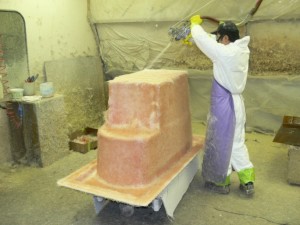Products & Services
- Product Design and Development
- Production Planning
- Inventory
- Just In Time Delivery
Processes
At Fibre Laminations Ltd. we produce parts using the following processes:
Hand Layup
The fibreglass in the form of chopped strand mat and/or woven cloth is cut from rolls, wetted out with catalyzed resin are placed in the mould by hand. Air bubbles are worked out using hand tools. The part is usually gelcoated first to provide a smooth coloured finish. This process is the simplest.
Sprayup / Chopper Gun
 The fibreglass in the form of a long string is pulled into the chopper gun head and cut into shorter lengths that are blown into the resin stream and shot into the mould. We use the latest non-atomizing guns from Magnum/Venus products known as their Fluid Impingement Technology (FIT). These guns allow more precise control of the placement of material in the moulds as well as dramatically reducing VOC emissions.
The fibreglass in the form of a long string is pulled into the chopper gun head and cut into shorter lengths that are blown into the resin stream and shot into the mould. We use the latest non-atomizing guns from Magnum/Venus products known as their Fluid Impingement Technology (FIT). These guns allow more precise control of the placement of material in the moulds as well as dramatically reducing VOC emissions.
We also employ closed moulding using 2 part moulds where precise control of the wall thickness and inner surface shape are required. These technologies include cold press moulding, resin transfer moulding (RTM), vacuum assisted light RTM, and resin infusion:
Resin Transfer Moulding (RTM)
The resin transfer moulding process involves the use of a 2 part mould set for producing parts that are moulded on both sides. This gives parts that have a more uniform thickness and can have features on the back side such as ribs, bosses, recesses, etc. Generally a vacuum is also used to facilitate the removal of air pockets.
Light Resin Transfer Moulding (RTM)
This process is similar to regular Resin Transfer Moulding but uses a lightweight countermould and relies on the vacuum to provide the mould clamping force. The tooling cost is a bit lower so this process lends itself well to parts that have a lower production volume.
Vacuum Infusion Moulding
Includes both vacuum bagging for limited production parts or moulds and closed cavity bag moulding (CCBM) that uses a re-useable bag for longer production runs. Your engineering requirements, production rate and budget will all determine which production technology will be best for your part or product.
All materials are metered using computer controlled measuring systems to give us tight control over weights and costs. Our multi-colour gelcoat systems also use FIT technology to improve efficiency and ultimate surface finish.
After de-moulding all parts go to our Trimming and Finishing department. There all parts are trimmed to their final size & shape, all holes are cut or drilled and every part is inspected to ensure quality and consistency.
When precise trimming tolerances are required we use our CNC machining center to trim, backface, drill and cutout your parts. Parts can be sanded or buffed as well as packaged for delivery to your plant or direct to your customers.